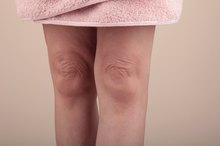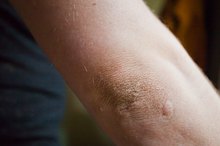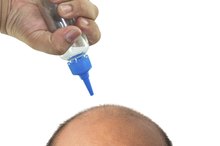What does fact checked mean?
At Healthfully, we strive to deliver objective content that is accurate and up-to-date. Our team periodically reviews articles in order to ensure content quality. The sources cited below consist of evidence from peer-reviewed journals, prominent medical organizations, academic associations, and government data.
- Department of Dermatology, Royal Prince Alfred Hospital, Camperdown, NSW: Tea Tree Oil Study
- Department of Dermatology, Royal Prince Alfred Hospital, Camperdown, NSW: Tea Tree Oil Study
The information contained on this site is for informational purposes only, and should not be used as a substitute for the advice of a professional health care provider. Please check with the appropriate physician regarding health questions and concerns. Although we strive to deliver accurate and up-to-date information, no guarantee to that effect is made.
How to Get Rid of Dark Pores on Legs
Dark pores are caused by impurities becoming trapped inside the skin. These impurities, including sebum, excess oil, dirt and bacteria, become lodged inside the pores and are oxidized, turning the pores brown. Often referred to as blackheads, dark pores can occur anywhere on the body, and can be difficult to eliminate because they do not usually respond to over-the-counter acne products. When dark pores appear on the legs, there are certain treatments and remedies that can be used to effectively eliminate them.
Soak the legs in a hot bathtub to open the pores and loosen dead skin. Fill a bathtub full of hot water, but not hot enough to scald the skin. Soak in the hot bath for at least 15 minutes, making sure to completely cover the areas affected by dark pores.
How to Get Rid of Large Pores on Legs
Learn More
Exfoliate the skin using a natural, mildly abrasive scrub, such as baking soda. Pour 1 tablespoon of baking soda into your hand, and mix 1 teaspoon of warm water into it. Spread the baking soda paste onto the area affected by dark pores, and gently massage it in using small, circular motions for three to four minutes.
Massage the legs with a tea tree oil mixture that will keep the pores free of bacteria. Pour 2 tablespoons of olive oil into your palm, and mix 2 drops of tea tree oil into it. Massage the oils into the areas affected by dark pores for at least three minutes. Allow the oils to remain on the skin and soak in 1.
Tips
Soaking the skin in hot water helps open up the pores, which can allow any entrapment to drain out more easily. Soaking the skin also loosens and softens dead skin cells that can become trapped inside the pores.
Exfoliating the skin with a natural scrub removes dead skin and bacteria that can become clogged in the skin, resulting in dark pores and blackheads. Since baking soda is comprised of smooth particulates, it can buff off dead skin without causing irritation or inflammation.
Tea tree oil is an antibacterial oil that can be used on the skin to kill off acne-causing bacteria and microbes. In order to use tea tree oil on the legs, it is important to dilute it into a 5 percent solution, which can be accomplished by combining 2 tablespoons of olive oil and 2 drops of tea tree oil.
Related Articles
References
- Acne Treatment Guru: Steaming the Skin
- Department of Dermatology, Royal Prince Alfred Hospital, Camperdown, NSW: Tea Tree Oil Study
- Wang S. Understudied skin characteristics awaiting genetic breakthroughs. J Investig Dermatol Symp Proc. 2018;19(2):S101-S102. doi:10.1016/j.jisp.2018.10.005
- American Academy of Dermatology Association. What can treat large pores?
- Draelos ZD. Cosmeceuticals for male skin. Dermatologic Clinics. 2018;36(1):17-20
- Milam EC, Rieder EA. An approach to cosmeceuticals. Journal of Drugs in Dermatology. 2016;15(4):452-6.
- Sakuma TH, Maibach HI. Oily skin: an overview. Skin Pharmacology and Physiology. 2012;25(5):227-35.
- Yeh L, Bonati LM, Silverberg NB. Topical retinoids for acne. Seminars in Cutaneous Medicine and Surgery. 2016;35(2):50-6.
- Zaenglein AL, Pathy AL, Schlosser BJ, et al. Guidelines of care for the management of acne vulgaris. Journal of the American Academy of Dermatology. 2016;74(5):945-73.








